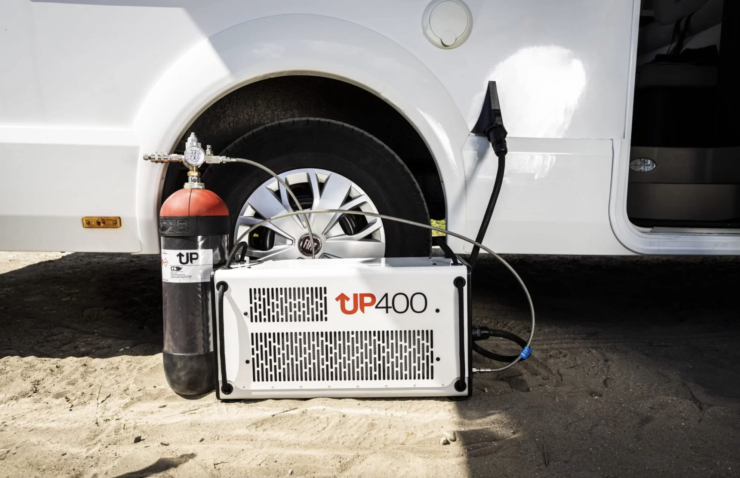PowerUP Energy Technologies Demonstrates Hydrogen Safety with Cylinder Experiments.
Recent years have shown a significant growth for the hydrogen fuel cell market. But despite these developments, a number of myths around hydrogen, particularly the safety of it, have remained. What if something happens to the cylinder containing hydrogen? The truth is, the safety of hydrogen cylinders are carefully designed, incorporating advanced technology and rigorous testing to guarantee reliability in real-world situations. PowerUP debunked the myth in a video-test.
PowerUP Energy Technologies, in collaboration with the Estonian Military, recently conducted comprehensive testing on two types of hydrogen cylinders to assess their durability and safety under various conditions. The testing focused on a crucial aspect: what happens if a hydrogen cylinder is accidentally dropped from a 1.6 metre height straight onto a concrete floor? This simulation mirrors real-world scenarios such as loading hydrogen cylinders onto vehicles for transportation or storing the cylinders above the ground.
Drop test: evaluating structural integrity
🔥 What about we co-host a webinar? Let's educate, captivate, and convert the hydrogen economy!
Hydrogen Central is the global go-to online magazine for the hydrogen economy, we can help you host impactful webinars that become a global reference on your topic and are an evergreen source of leads. Click here to request more details
The initial examination involved a drop test, wherein both the CTS Cylinder and the Rheingas 26L Wechselflasche Cylinder were released from a 1.6-meter-high platform onto a concrete surface, simulating a worst-case scenario. The cylinders were placed upright in their normal standing position and then tipped over the edge to fall on the concrete. It represents the loading of hydrogen onto a transportation vehicle and the accidents that can happen during this process.
The drop test outcomes were categorised into four possibilities, each indicating the cylinder’s response to impact:
- Total explosion/rupture of inner cylinder structure.
- Cracked/damaged outer structure, internal structure cracked/damaged, catastrophic leakage rate.
- Cracked damaged outer structure but intact inner structure, small or no significant leak (less than 25 ppm).
- No damage to the inner or outer structure, small scratches.
Outcomes 1 and 2 were deemed as failures, while outcomes 3 and 4 were considered successful.
The first cylinder, the CTS Cylinder, demonstrated resilience by achieving the fourth outcome – no damage to the inner or outer structure, passing the test. The second cylinder type, Rheingas 26L Wechselflasche, attained outcome number 3, also securing a pass in the evaluation.
Overall Test Results
Simply put, hydrogen is safe, comparable to gasoline, diesel, and natural gas. The tanks that store hydrogen undergo thorough testing, including crash and gunfire simulations, meeting strict performance standards. What makes them stand out is their construction using strong composite materials, even stronger than regular steel.
As seen from the video, both the CTS Cylinder, as well as the Rheingas 26 L Wechseflasche cylinders, are tough and secure, ensuring reliability in different sectors. This contributes to debunking common misconceptions and underscores the suitability of hydrogen as a safe and reliable energy source for a variety of applications.
PowerUP Energy Technologies’ commitment to hydrogen safety is evident, fostering a more accurate understanding of the reliability and security inherent in hydrogen fuel technology for both home and business users.
READ the latest news shaping the hydrogen market at Hydrogen Central
PowerUP Energy Technologies Demonstrates Hydrogen Safety with Cylinder Experiments. source








